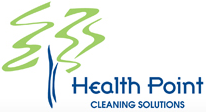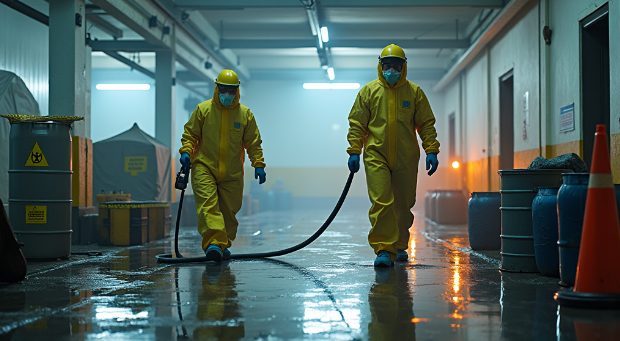When dealing with biohazard situations, knowing the right Biohazard Remediation Techniques is crucial. These techniques ensure that spaces are safe and clean after an incident. This guide will help you understand the key methods used in biohazard cleanup. Whether you are a business owner or just curious, you’ll find useful insights here.
Table of Contents
Key takeaways
- Biohazard remediation is important to protect health.
- Proper cleaning prevents the spread of germs and diseases.
- Professional services are often necessary for safety.
- Always follow local guidelines in Phoenix, AZ.
- Understanding the process helps in making informed decisions.
- For detailed information on hazardous waste disposal, check our Hazardous Waste Management.
What are Biohazard Remediation Techniques?
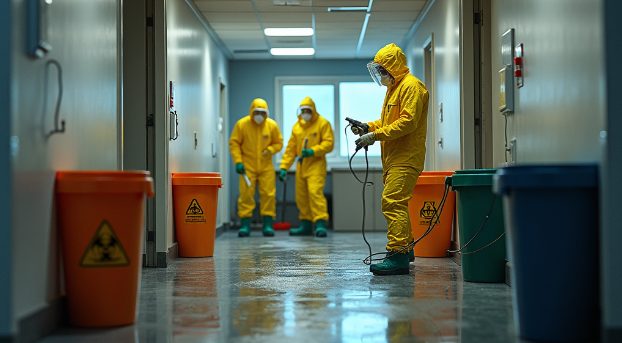
Biohazard remediation refers to the process of cleaning and removing materials that may pose health risks. This can include blood, bodily fluids, chemicals, or other hazardous materials. The goal is to make the area safe for people to return. In Phoenix, AZ, specific protocols are followed to ensure safety and compliance with local laws.
Understanding Biohazard Remediation Techniques
A biohazard is any biological substance that can harm humans. This includes pathogens like bacteria, viruses, and other harmful microorganisms. When an accident happens, such as in a medical facility or at home, it can create a biohazard situation. Cleaning up these materials is not just important, it is necessary for public health.
Why is Biohazard Remediation Techniques Cleanup Important?
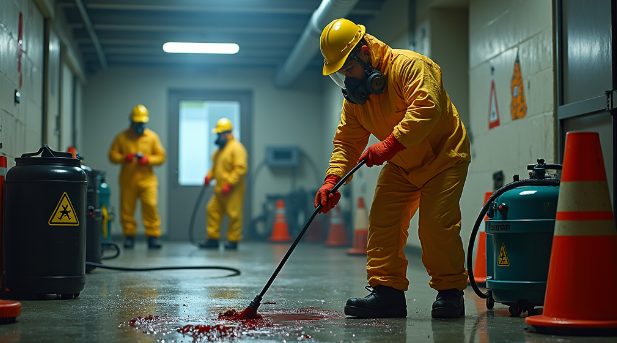
Cleaning biohazards is vital for several reasons. First, it protects people’s health. Exposure to pathogens can cause serious illnesses. Second, proper cleanup helps maintain a safe environment. This is especially important in places like hospitals, schools, and businesses, where many people gather. Finally, it ensures compliance with local health regulations, which is crucial for avoiding legal issues.
Risks of improper cleanup
Failing to clean up biohazards correctly can lead to several risks. You might expose yourself or others to dangerous germs. There is also a chance of spreading infections. In some cases, improper cleanup can create legal problems, too. For example, if a business does not follow health guidelines, it could face fines or even lawsuits.
The Biohazard Remediation Techniques Cleanup Process
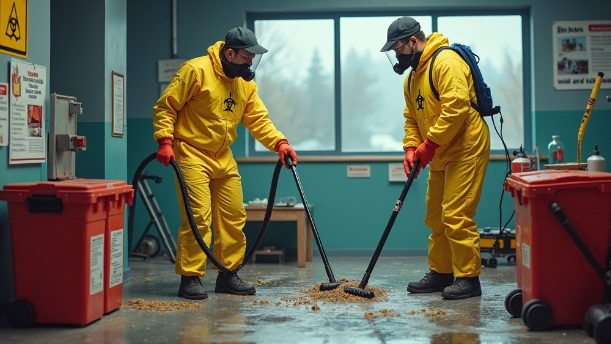
Cleaning up biohazards involves several steps. Each step is crucial for ensuring safety. Here’s a closer look at the process.
Assessment
The first step in any biohazard cleanup is assessment. This means looking at the area to see what needs to be cleaned. It’s important to identify the type of biohazard and how extensive the situation is. This can often require trained professionals who know what to look for.
Containment
Once the area is assessed, the next step is containment. This means making sure that the biohazard materials do not spread. Containment often involves using barriers or special bags for cleaning materials. This step protects the rest of the area and keeps everyone safe.
Removal
After containment, the actual removal of biohazard materials takes place. This is a critical step. Trained professionals use special equipment to safely remove the materials. It’s important to follow strict guidelines during this phase. In Phoenix, companies must adhere to all local regulations.
Cleaning and disinfecting
Next, the area must be cleaned and disinfected. This helps ensure that all harmful germs are eliminated. Professional cleaners use specific cleaning agents that are effective against biohazards. This step is vital in preventing infections and ensuring safety.
Proper disposal
The final step is the proper disposal of biohazard materials. This involves taking the waste to a facility that is authorized to handle it. In Phoenix, there are specific guidelines for how to dispose of biohazard waste. Following these rules is crucial to protect public health.
| Step | Description | Importance |
|---|---|---|
| Assessment | Identify the type and extent of biohazard | Establishes appropriate cleaning measures |
| Containment | Prevents spread of hazardous materials | Protects health and safety of surrounding areas |
| Removal | Safe extraction of biohazard materials | Ensures proper handling and reduces risk |
| Disposal | Safe disposal of hazardous waste | Complies with local regulations |
Tools and Equipment for Biohazard Cleanup
Using the right tools is essential for effective biohazard remediation. Here are some common items used during cleanup.
Personal protective equipment (PPE)
PPE is crucial for anyone involved in biohazard cleanup. This includes gloves, masks, goggles, and protective clothing. Wearing PPE helps prevent exposure to harmful materials. It is a standard practice that protects both the workers and the public.
Cleaning agents
Effective cleaning agents are used to disinfect areas after a biohazard incident. These agents kill germs and help ensure the space is safe. It’s important to choose products that are specifically designed for biohazard cleanup.
Containment supplies
Containment supplies, such as bags and barriers, are essential for keeping the area safe during cleanup. These supplies help prevent the spread of pathogens. They ensure that waste is kept secure until it can be properly disposed of.
Common Biohazard Situations
Various situations can lead to a biohazard cleanup. Understanding these can help in knowing when to seek help.
Medical emergencies
In medical settings, accidents can occur that result in biohazardous materials being present. For example, a spill of blood or other bodily fluids requires immediate cleanup. Proper protocols must be followed to ensure safety.
Crime scenes
Crime scenes often have biohazard materials, such as blood or tissues. Cleanup in these situations is complex. It requires trained professionals who understand the legal and health implications.
Hoarding situations
Hoarding can lead to unsanitary conditions. In some cases, this can create biohazard situations. Cleanup in these cases requires sensitivity and expertise to handle the materials safely.
Additional biohazard scenarios to be aware of:
- Drug Overdose Sites: Cleanup may be necessary due to drug-related incidents involving needles or bodily fluids.
- Animal Waste: Situations involving deceased or contaminated animals can create biohazards.
- Infectious Disease Outbreaks: Areas affected by outbreaks require thorough cleaning to prevent spread.
The Role of Professionals in Biohazard Remediation Techniques
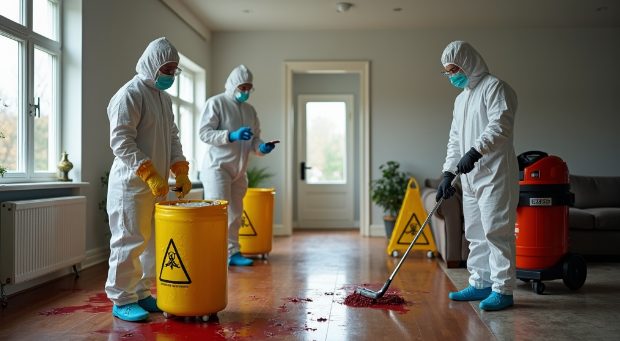
While some simple cleanups can be done by individuals, many cases require professionals. Here’s why hiring experts is often the best choice.
Training and expertise
Professional cleanup teams are trained to handle biohazards. They know the proper techniques and safety measures necessary for effective remediation. This minimizes health risks and ensures thorough cleaning.
Access to equipment
Professionals have access to specialized equipment. This equipment is designed to handle biohazard materials safely. Using the right tools can make cleanup more effective and efficient.
Knowledge of regulations
In Phoenix, there are laws governing biohazard cleanup. Professionals are familiar with these regulations. They can ensure that all cleanup meets local health and safety standards. If you want to learn more about local regulations, consider visiting our page on Local Health Regulations.
How to Choose a Biohazard Remediation Techniques Cleanup
If you need to hire a service, it’s important to choose the right one. Here are some tips for making a good choice.
Check for certifications
Make sure the company has the necessary certifications. This shows that they are qualified to handle biohazard cleanup. In Phoenix, look for certifications from local health departments or safety organizations.
Read reviews
Look for customer reviews and testimonials. This can help you understand the quality of the service. Positive feedback is a good sign that the company is reliable.
Get estimates
Before making a decision, get a few estimates from different companies. This gives you an idea of the cost and services offered. Compare the estimates to find the best fit for your needs.
| Type of Waste | Examples | Disposal Method |
|---|---|---|
| Infectious Waste | Blood, used syringes | Incineration or autoclaving |
| Hazardous Waste | Chemicals, solvents | Licensed hazardous waste facilities |
| Non-Hazardous Waste | Regular office waste | Regular landfill disposal |
Preventing Biohazard Remediation Techniques Situations
Prevention is always better than dealing with a cleanup. Here are some ways to prevent biohazard situations in the first place.
Regular cleaning
Keeping spaces clean regularly can help prevent biohazard situations. This is especially important in places like hospitals or schools, where many people are present. Regular cleaning reduces the risk of germs spreading.
Safe disposal
Make sure to dispose of waste properly. This includes medical waste, chemicals, and other hazardous materials. Following local guidelines helps keep the community safe.
Training staff
In businesses, training staff on biohazard protocols is essential. Employees should know how to respond to emergencies. This training can help prevent situations from escalating.
Understanding Biohazard Waste
Not all waste is the same. Here’s a look at different types of biohazard waste.
Infectious waste
This type includes materials that can transmit infections. Examples are blood-soaked items, used syringes, and other medical waste. Proper handling and disposal of this waste are crucial.
Hazardous waste
Hazardous waste includes chemicals that can harm people or the environment. This can include cleaning agents or industrial waste. Special care must be taken when dealing with this type of waste.
Non-hazardous waste
Not all waste is dangerous. However, even non-hazardous waste must be disposed of correctly. Keeping waste organized and properly managed prevents future issues.
Conclusion
Biohazard remediation is an important process that safeguards health and safety. Knowing the techniques can help you understand what to expect in a cleanup situation. Whether you are a business owner or just want to learn more, this guide provides valuable insights into the importance of proper biohazard cleanup.
Your next steps
If you ever find yourself in need of biohazard cleanup, remember the steps outlined in this guide. Whether it’s assessing the situation or hiring professionals, understanding the process is key. Always prioritize safety and follow local guidelines in Phoenix, AZ. If you have any questions or need assistance, don’t hesitate to reach out to local cleaning services that specialize in biohazard remediation.
